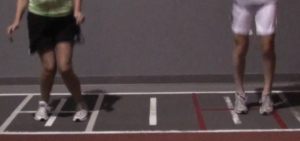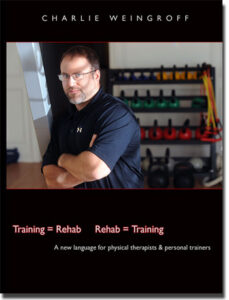Review of Rehab=Training, Training=Rehab: Top 10 Takeaways – Part 2
Today, we’ve got a follow-up of my blog from late last week, Rehab=Training, Training=Rehab: Top 10 Takeaways – Part 1. This mini-series highlights some of the key takeaways from Charlie Weingroff’s great new DVD set, which is on sale at an introductory price through midnight tonight only. We pick up today with #6.
6. I’ve written a lot in the past about why a hip internal rotation deficit (HIRD) is a huge problem in both athletes and the general population. Weingroff raises an interesting point in discussing the “Hip Internal Rotation Paradox” that I’d never really considered – probably because nowadays, I really don’t train as many female athletes where we see valgus-initiated knee and lower leg injuries. In this population, we see lower extremity pathologies largely because a lot of females can’t control femoral/tibial internal rotation and pronation at the subtalar joint (left side in the photo below).
The casual observer to kinesiology might say that a good way to prevent these injuries would be to make sure that athletes have insufficient internal rotation and pronation; if you can’t hit a dangerous end-range, then you can’t tear anything nearly as easily. Hooray for HIRD then, right? Wrong.
The problem with this thought process, though, is that it doesn’t appreciate that the hip DOES need full internal rotation for proprioception. As Charlie puts it, the hip “needs to know it to prevent it.” If we don’t have adequate proprioception, we can’t get the hip external rotators to turn on to prevent it from becoming excessive. This is really true of all joints; we must have full mobility so that the mechanoreceptors can tell the brain that a joint can go from point A to point B. Otherwise, we can’t stabilize naturally and reflexively.
7. Weingroff reaffirmed a great assertion that I remember Bill Hartman making a year or two ago: you only need stability in the presence of mobility. In other words, “functional” mobility is not just about being capable of adequate stability in wild excursions of joint range of motion – unless that’s what your functional demands are. In other words, a powerlifter, gymnast, and baseball pitcher would all have different “optimal mobility” schemes, and even within these populations, you’d see different needs for different folks based on body type and the specific activity in question.
This also can influence our training programs. While exactly simulating the sporting movement will only lead to overuse without enhancing functional mobility, working to improve stability in similar joint alignments and ranges of motion can still have a favorable carryover. This came to mind the other day when Kansas City Royals prospect Tim Collins was doing some core work at the facility; you just have to consider the movement alongside his functional demands.
8. Charlie also cited some more up-to-date research that shows that problem with lateral knee pain is usually too much femoral internal rotation during closed chain movements (e.g., squatting, lunging), not too much lateral patellar tracking. So, you think the hundreds of thousands of lateral release surgeries that have been performed in the last decade were a good idea? A lot of people could have gotten their issues under control the right way by getting the hip under control – because the patella was already where it was supposed to be.
9. I liked the way that Weingroff broke corrective exercise down into three categories: isolated, integrated, and functional movement.
Isolated work might include manual therapy (massage or joint mobilizations) or stretching. Essentially, this category consists of interventions where the client/patient has little to no active participation (foam rolling would technically be a mild exception, as the client has to actively reposition his/her body for this soft tissue work). Effectively, these modalities get the ball rolling on undoing a dysfunction that won’t clear up with gross movement because the individual with the problem will simply go to the path of least resistance and feed into that dysfunction.
Integrated work is aimed at tying this new mobility with the core – whether it’s with a more comprehensive mobility drill or stabilization exercise. Many people can benefit from going directly to integrated work; examples include someone who has always trained on machines, or someone who sits at a desk all day; they simply need to move).
Functional movement is the third piece of the puzzle and involves tying the upper and/or lower extremity to the core. This is the fun stuff.
10. There is a difference between functional movement and functional exercise. This might seem like wordplay, but in reality, it’s an important differentiation to make.
Charlie cited the example of a baby going into lumbar flexion when squatting down. It’s a range-of-motion that a child should have and utilize in normal development and day-to-day living. That doesn’t, however, mean that it’s a good idea to put 405 on your back and squat through lumbar flexion.
That wraps up my not-so-quick recap of Rehab=Training, Training=Rehab. To be honest, I could have written another dozen blog posts just like this on all the other stuff – both “big picture” points and finer subtleties – that I picked up from Charlie’s presentation. That, however, is best left to Charlie – which is why I’d strongly encourage you to pick up a copy of the DVD set yourself, especially since it is on sale at the introductory price ($50 off) through Monday 12/20 at midnight. You won’t regret it:






